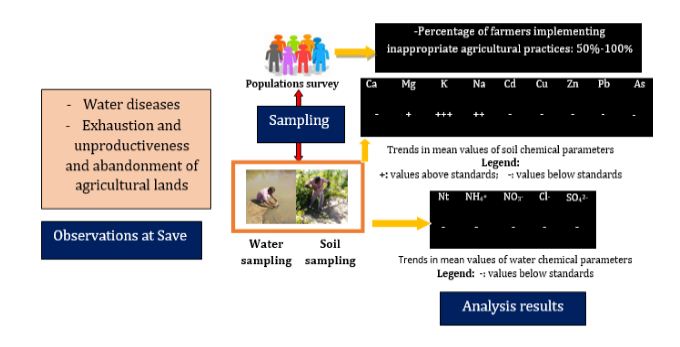Document Type : Original Research Article
Authors
- Mickael Vitus Martin Kpessou Saizonou 1
- Alassane Abdou Karim Youssao 1
- Magloire Acakpo Nonvignon Gbaguidi 1
- Nicephore Sourou Koutchoro Date 2
- Azim Mohamed Abibou 1
- Samson Ahognonhou Agossou 1
1 Ecotoxicology and Quality Study Research Unit – Laboratory of Study and Research in Applied Chemistry - Polytechnic School of Abomey-Calavi University of Abomey-Calavi, Benin 01 BP 2009 Cotonou Benin
2 Institute of Geography, Spatial Planning and Environment University of Abomey-Calavi, Benin 01 BP 2009 Cotonou, Benin
Abstract
Agricultural practices are increasingly affecting the environment. Various diseases related to environmental pollution are recorded everywhere due to new agricultural practices. Indeed, agricultural inputs, pesticides, and herbicides destroy the quality of waterways and soils and affect the health of populations as well as the use of machinery that is not suitable for agricultural activities. This is the case of Save in Benin. Certain water-borne diseases are common in the region and are linked by the populations to agricultural practices. This study aims to find the correlations between these practices and the quality of biophysical environment to confirm or not, the concerns of the populations. It was made by surveys with 150 people and analyses of samples of water and soil by standards methods in the area. The results of physical and chemical parameters obtained reveal positive correlations between agricultural practices and soil impoverishment. Indeed, for example, 21% of those enquired use only herbicide for land clearing and 49 %, intensely chemical inputs. Similarly, 50 % of soils contain arsenic. The values of parameters of surface waters are generally in line with the World Health Organization (WHO) recommendations. But on some sites, the total nitrogen concentration, of up to 2840 ppm, is above the standards and also that of magnesium, whose value is 2278 ppm. These findings provide information on the importance of the number of farmers using chemical inputs and the quality of soils and surface water. The results obtained partly justify the assertions of the populations regarding their concerns.
Graphical Abstract
Keywords
Main Subjects
- Acclassato, Ten years after the Maputo declaration on agriculture and food security: an assessment of progress, West Africa structure and content of country studies. European Centre for Development Policy Management (ECDPM), Special edition, ROPPA, Benin study, (2013).
- Aho, G. Capo-chichi, African cotton between traditions and modernity practices: the new paradigm of a social economy in West Africa. Bull. Search Agron. Benign.Special Issue Sustainable Agricultural Development, (2017) 35-48.
- laurent, Agriculture and pollution of water: modeling of processes and analysis of territorial dynamics. University of Maine, Environmental Sciences, (2012).
https://tel.archives-ouvertes.fr/tel00773259
- Le Guillou, Diagnosis and mapping of environmental pollution risks (water, plants, soil) by metallic trace elements around camelina farms in Kazakhstan. University of Montpellier II (UM II), Master in Biology Geosciences Agro-Resources Environment, Functional Ecology and Sustainable Development, Livestock of Southern Countries: Environment, Development, and Internship. Report of Master, (2009) https://agritrop.cirad.fr/555068
- A. Bachabi, A. C. Agbon, M. S. Issa, M. Boko, Impacts of Conventional Cotton Production on Water Quality in the Alibori to Benin Catchment Area. European Scientific Journal, 16 (2020) 436-454.
- Amonmide, G. Dagbenonbakin, C.E Agbangba, I. Akponikpe, Contribution to the evaluation of the level of soil fertility in cotton-based cropping systems in Benin. International Journal of Biological and Chemical Sciences, 13 (2019)1846-1860.
- Coulibaly, E. Vall, P. Autray, H. Nacro, M. Sedogo, Effects of permanent cotton-maize cultivation on the evolution of soil fertility indicators in western of Burkina Faso. International Journal of Biological and Chemical, 6 (2012) 1069-1080.
- B. Pouya, M. Bonzi, Z. Gnankambary, K. Traore, J.S. Ouedraogo, A. Some, M. P. Sedogo, Current soil fertility management practices and their effects on cotton production and on the soil in cotton farms in central and western Burkina Faso. Cahiers Agricultures, 22 (2013) 282-292.
- M’biandoun, J.M. Douzet, Evolution of the fertility of the soils under cultivation in the landscaping carried out in 1996. Report on the analysis of the results, IRAD-DPGT-SODECOTON. Garoua, North Cameroon, (2000). Tropicultura 24 (4) (2000) 247-252
- J.P. Bassala, M. M’biandoun, A. Ekorong, P. Asfom, Evolution of soil fertility in a cotton-cereal system in northern Cameroon: diagnosis and prospects, sommaire/inhoud/sumario, 26 (2008)240-245.
- S.A. Ballot, G. Mawussi, W. Atakpama, M. Moita-nassy, M.T. Yangakola, I. Zinga, S. Silla, W. Kperkouma, G. Dercon, B. Komlan, A. Koffi, Physico-chemical characterization of soils to improve cassava productivity (Manihot esculenta Crantz) in the Damara region in south-central Central Africa Republic.. African Agronomy, 28 (2016) 9-23.
- Decree No. 2001-094 of 20 February 2001 setting drinking water quality standards in the Republic of Benin, (2001) 1-15.
- Ifremer Environment, Hydrological parameter/Dissoled Oxygen .France, Parameter sheet, (2017).
https://ocean-indien.ifremer.fr/content/download/106171/file/Fiche_Oxygene_dissous.pdf
- L. Hubiche, The dynamics of life, water support of life: the oxygen of water. Cahier Indicator N°1, (2002).
https://www.loire-estuaire.org/upload/iedit/1/pj/43684_2860_CMB_206106_L2A1.pdf
- CRE, Dissolved oxygen. Quebec, Article, (2009)
https://crelaurentides.org/wp-content/uploads/2021/10/fiche_oxygene.pdf
- Delaunois, Y. Ferrie, M. Bouche, C. Colin C. Rionde, Guide for the description and evaluation of soil fertility. France, Tarn’s Agriculture chamber and INRA of Montpellier, (2013)
https://tarn.chambre-agriculture.fr
- Bispo, C. Chenu, M. Griffon, E. Lemaire, C. Valentin C. Walter, What research on agricultural soils? National Agency of Research (ANR), (2013) https://anr.fr/fileadmin/documents/2015/ANR_Plaquette_SOLS.pdf
- A. Doumbia, Diagnosis of soil fertility in the cotton zone of Mali: Studies on soil organic matter. Republic of Mali, Rural Polytechnic Institute for Training and Applied Research (IPR/IFRA) of Katibougou, Master's thesis, (2007)
http://www.secheresse.info/spip.php?article43824
- FAO, Soil badge. Youth United Nations Global Alliance (YUNGA). Learning and Action Series, (2015). https://www.fao.org/yunga/resources/challenge-badges/soils/en/
- E. Kouadio, K. E. Koffi, B. J. Kouakou, F. G. Messoum, B. Kouame, B. D. N'guessan.Diagnosis of the fertility status of soils under cotton cultivation in the main production basins of Ivory Coast. European Scientific Journal, 14 (2018) 221-238.



